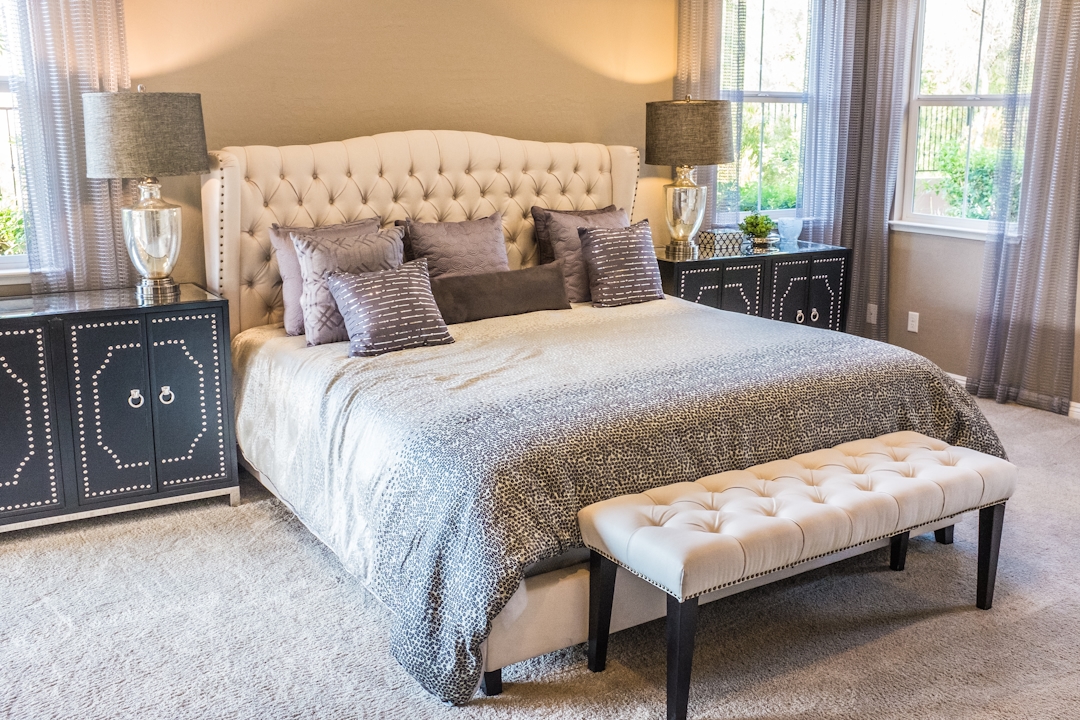
Creating a Sleep Sanctuary: Tips for a Restful Night's Sleep
Discover essential tips to transform your bedroom into a sleep sanctuary for a more restful and rejuvenating night's sleep.

Audio Summary
Key Takeaways
Craft a Serene Environment
- Declutter your bedroom
- Manage light and temperature
- Reduce noise disturbances
Develop Good Sleep Hygiene
- Stick to a consistent sleep schedule
- Establish a relaxing bedtime routine
- Be mindful of pre-sleep eating and drinking habits
Personalize Your Space
- Choose comfortable bedding
- Incorporate soothing decor
- Add elements that promote relaxation and happiness
Introduction to Creating Your Perfect Sleep Sanctuary
A good night's sleep is essential for our overall health and well-being, yet many of us struggle to get the rest we need. Creating a sleep sanctuary in your bedroom can make a significant difference in the quality of your sleep. A sleep oasis is a peaceful and comfortable environment designed to promote relaxation and encourage restful slumber.
By optimizing your bedroom for sleep, you can set the stage for more rejuvenating nights and energized days. This guide explores various tips and strategies to help you transform your bedroom into the perfect sleep haven, ensuring you wake up feeling refreshed and ready to tackle the day ahead.
Key Elements of a Sleep Sanctuary
- Comfortable Bedding: Invest in high-quality mattresses, pillows, and bedding.
- Optimal Temperature: Maintain a cool, comfortable room temperature.
- Dark Environment: Use blackout curtains or eye masks to minimize light exposure.
- Quiet Atmosphere: Reduce noise with soundproofing or white noise machines.
- Calming Colors: Choose soothing, muted tones for walls and decor.
- Clutter-Free Space: Keep your bedroom tidy and organized.
- Aromatherapy: Incorporate relaxing scents like lavender or chamomile.
- Proper Ventilation: Ensure good air circulation for a fresh sleeping environment.
By implementing these elements, you can create a tranquil sleep sanctuary that promotes restful nights and energized mornings.
Create a Serene Sleep Environment
Crafting a serene sleep environment is the first step in building your sleep sanctuary. By focusing on key elements, you can transform your bedroom into a calm, peaceful space that encourages restful slumber and better sleep hygiene.
- Declutter Your Space: A tidy bedroom helps your mind relax and reduces stress. To create a serene environment: Remove items that don't belong in the sleeping area, such as work materials or exercise equipment. Organize personal belongings, Keep surfaces clear and clean.
- Optimize Lighting: Proper lighting plays a crucial role in preparing your body for sleep: Use soft, warm-toned bulbs in lamps, consider installing dimmer switches, make your room as dark as possible when it's time to sleep, invest in blackout curtains or use an eye mask to block out unwanted light.
- Regulate Temperature: Maintain an optimal sleeping temperature: Aim for a cool room between 60- and 67-degrees Fahrenheit (15.5 to 19.4 degrees Celsius), Adjust your thermostat or use a fan to maintain a comfortable temperature throughout the night.
- Minimize Noise: Reduce sleep disruptions caused by noise: Use a white noise machine or fan to create consistent background sound, consider earplugs if you live in a particularly noisy area, Soundproof your room if necessary.
- Incorporate Soothing Scents: Create a calming atmosphere with pleasant aromas: Use lavender for its relaxation-promoting properties, Try a lightly scented air freshener, essential oil diffuser, or sachet in your pillowcase.
By implementing these strategies, you can create a tranquil sleep environment that promotes better sleep quality and overall well-being.
Cultivate Healthy Sleep Habits
Creating a sleep sanctuary isn't just about your physical space—it's also about cultivating good sleep habits. These habits, often called sleep hygiene, can significantly improve your sleep quality and overall rest.
- Maintain a Consistent Sleep Schedule: Go to bed and wake up at the same time every day, including weekends, this helps regulate your body's internal clock, making it easier to fall asleep and wake up naturally.
- Establish a Relaxing Bedtime Routine: Engage in calming activities before bed, such as: Reading a book, taking a warm bath, Practicing gentle stretches, Consistent routines signal to your body that it's time to wind down and prepare for sleep
- Mind Your Diet: Avoid caffeine late in the day, Refrain from eating heavy meals close to bedtime, be mindful of alcohol consumption, as it can disrupt sleep patterns.
- Exercise Regularly, But Time It Right: Engage in regular physical activity to improve sleep quality, finish vigorous workouts at least a few hours before bedtime, Consider gentle exercises like yoga or stretching in the evening.
- Manage Screen Exposure: Limit exposure to blue light from phones, tablets, and computers before bed, try to avoid screens for at least an hour before sleep, Use blue light filtering apps or glasses if device use is necessary.
- Create a Comfortable Sleep Environment: Ensure your bedroom is dark, quiet, and cool, invest in a comfortable mattress and pillows, Use breathable, comfortable bedding.
By developing these healthy sleep habits, you'll complement your sleep-friendly environment and set yourself up for better, more restful nights and improved sleep health. Remember, consistency is key when it comes to establishing new routines and habits.
Customize Your Sleep Sanctuary
Creating a sleep sanctuary is a personal journey that goes beyond following general guidelines. Customizing your sleep space can help you feel more relaxed and comfortable, leading to better sleep quality and overall rest.
- Personalize Your Bedding: Choose bedding that feels good to you, consider crisp, cool sheets or soft, cozy ones based on your preference, select colors and patterns that promote calmness and happiness, invest in pillows that support your sleeping style (side, back, or stomach sleeper)
- Add Personal Touches: Hang artwork that you find soothing or inspiring, display photos of loved ones or happy memories, incorporate items that make your bedroom feel safe and comforting.
- Incorporate Plants: Add plants to brighten up your room, consider sleep-promoting plants like lavender or jasmine, choose low-maintenance options that don't require much care
- Create a Relaxation Zone: Set up a cozy reading nook with a comfortable chair and good lighting, use a diffuser with your favorite essential oils for calming scents, include elements that help you unwind, such as a small fountain or a white noise machine.
- Reflect Your Personality: Experiment with different elements until you find the perfect combination, remember that what works for others might not work for you, adjust your space as needed to maintain comfort and relaxation.
By customizing your sleep space, you're creating a room that not only promotes good sleep but also feels like a true sanctuary. This personalized approach can help you fully relax, recharge, and improve your sleep health. Remember, your sleep sanctuary should evolve with your needs and preferences. Don't be afraid to make changes as you discover what works best for you in achieving restful and rejuvenating sleep.
Conclusion: Embrace Your Sleep Sanctuary
Creating a sleep sanctuary is a crucial step towards improving your sleep quality and overall well-being. By focusing on three key areas – crafting a serene bedroom environment, cultivating healthy sleep habits, and customizing your sleep space – you can transform your bedroom into the perfect place for restful nights and optimal sleep health. Remember, creating a sleep sanctuary doesn't have to be complicated or expensive. Small changes can make a significant difference in how well you sleep. By implementing these tips and finding what works best for you, you can create a bedroom environment that promotes better sleep and helps you wake up feeling refreshed and energized. As you embark on this journey to improve your sleep health, be patient and allow yourself time to adjust to new habits and environments. Continuously refine your sleep sanctuary based on your experiences and preferences. With dedication and attention to your sleep needs, you'll create a personalized oasis that supports restful nights and vibrant days. Sweet dreams await in your new sleep sanctuary!
References
- Danielle Patrick Pacheco, 'Tips for Turning Your Bedroom into a Sleep Sanctuary,' MOBE, accessed July 5, 2024, https://www.mobeforlife.com/blog/tips-for-turning-your-bedroom-into-a-sleep-sanctuary
- '8 Secrets to a Good Night's Sleep,' Harvard Health, accessed July 5, 2024, https://www.health.harvard.edu/newsletter_article/8-secrets-to-a-good-nights-sleep
- 'Mastering Sleep Hygiene: Your Path to Quality Sleep,' Sleep Foundation, accessed July 5, 2024, https://www.sleepfoundation.org/sleep-hygiene
- 'How to Finally Get Some Rejuvenating Sleep Naturally!' Arbor Health, accessed July 5, 2024, https://www.arbor-health.com/blog/Get-Some-Sleep
- 'How to Create a Sleep Sanctuary: 6 Tips For a Good Night's Sleep,' Avocado Green Mattress, accessed July 5, 2024, https://magazine.avocadogreenmattress.com/sleep-santuary-good-night-sleep/

Related Blog Content

The Role of Sleep in Physical Health: Boost Your Fitness with Quality Rest
Discover how quality sleep enhances your fitness, aids recovery, and boosts overall physical health for an active lifestyle.
Read More
Stress-Free Living: Effective Techniques for Managing Daily Stress and Enhancing Well-being
Discover practical strategies to manage daily stress and boost your overall well-being for a healthier, happier life.
Read More
Creating a Healthier Home: Simple Family Wellness Tips for a Happier Life
Learn how to improve family wellness, physical health, emotional well-being, and family bonds for a happier and healthier life together.
Read MoreReady to optimize your biology?
Nutritionaly is free to start. Build better habits, unlock insights, and watch your Bio-Score rise.